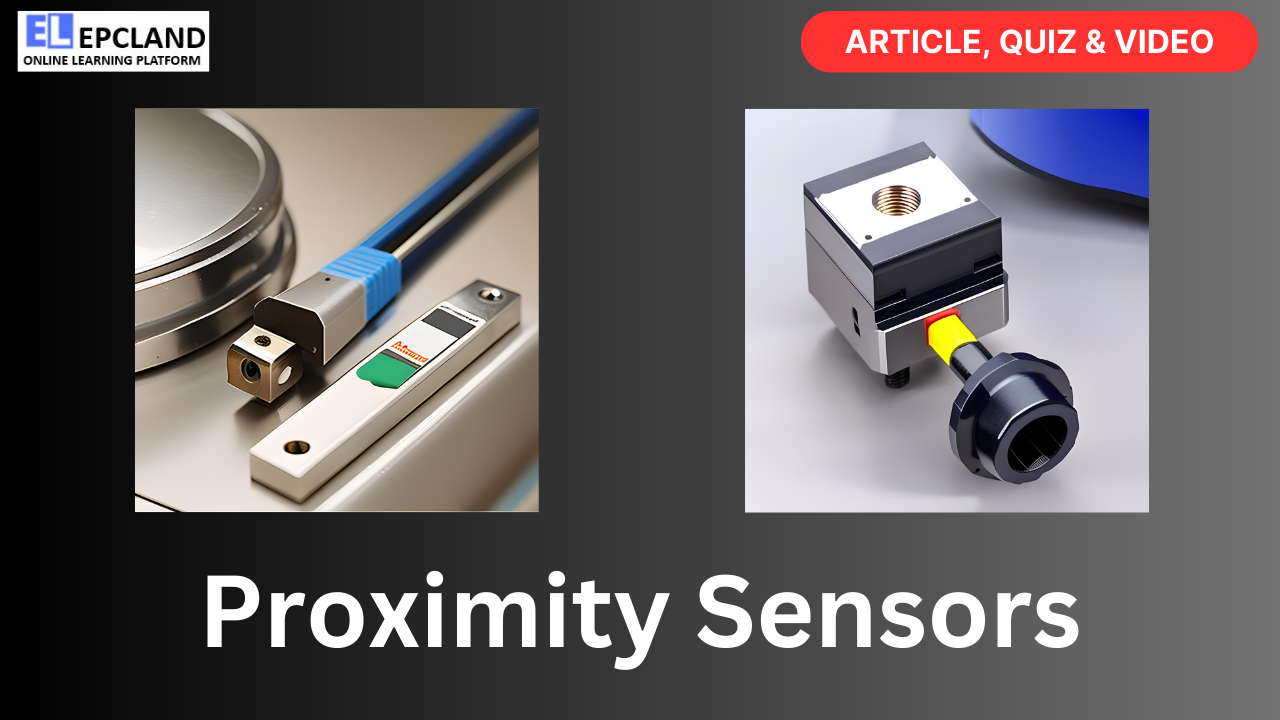The Oil and Gas Industry is renowned for its complex and hazardous operations, where precision and safety are paramount. One essential component contributing to the industry’s efficiency and safety is the use of proximity sensors. These devices play a vital role in various aspects of oil and gas projects, from drilling and exploration to refining and transportation. In this article, we’ll delve into the world of proximity sensors, exploring their significance, types, working principles, applications, and the ways they contribute to making oil and gas projects safer and more efficient.
Table of Contents
Do not miss the Complete Course on Piping EngineeringBy EPCLand
By EPCLand
Introduction to Proximity Sensors
Proximity sensors, often referred to as proximity switches, are devices designed to detect the presence, absence, or distance of an object within a defined range. They work based on different principles, including electromagnetic, ultrasonic, capacitive, and inductive. In the Oil and Gas Industry, these sensors are used extensively to monitor equipment, control processes, and ensure the safety of both personnel and assets.
Significance of Proximity Sensors in the Oil and Gas Industry
The use of proximity sensors in the Oil and Gas Industry is driven by several critical factors:
1. Safety
Safety is paramount in the industry due to the inherent risks associated with oil and gas operations. Proximity sensors are integral to safety systems, helping to prevent accidents and protect workers by detecting the presence of objects, ensuring machinery stops when necessary, and triggering emergency shutdown procedures.
2. Efficiency
Efficiency and productivity are vital for profitability in the Oil and Gas Industry. Proximity sensors improve efficiency by automating processes, reducing downtime, and optimizing resource utilization.
3. Asset Protection
Oil and gas operations involve expensive and critical equipment. Proximity sensors are used to monitor the condition of equipment, detecting anomalies and wear, which allows for timely maintenance and asset protection.
4. Environmental Compliance
Stringent environmental regulations require oil and gas companies to minimize leaks, spills, and emissions. Proximity sensors help detect leaks and control valves to prevent environmental hazards.
Types of Proximity Sensors
Proximity sensors come in various types, each suited to specific applications within the Oil and Gas Industry:
1. Inductive Proximity Sensors
Inductive proximity sensors are based on electromagnetic induction. They are used to detect metallic objects and are commonly employed in equipment monitoring, conveyor systems, and automated drilling operations.
2. Capacitive Proximity Sensors
Capacitive proximity sensors can detect both metallic and non-metallic objects. They are useful for level sensing, especially in tanks and vessels where liquid levels need to be monitored.
3. Ultrasonic Proximity Sensors
Ultrasonic proximity sensors use sound waves to detect objects. They are ideal for measuring distances and are used in applications such as level measurement in tanks and pipeline inspection.
4. Photoelectric Sensors
Photoelectric sensors use light beams to detect the presence of objects. They are versatile and can be used in various applications, including detecting the movement of materials on conveyor belts and monitoring equipment.
5. Magnetic Proximity Sensors
Magnetic proximity sensors are suitable for detecting ferrous materials. They are used in equipment positioning and control.
Do not miss the Complete Course on Piping EngineeringBy EPCLand
By EPCLand
Working Principle of Proximity Sensors
Proximity sensors operate based on various principles:
1. Inductive Proximity Sensors
Working Principle: Inductive proximity sensors emit an electromagnetic field from a coil. When a metallic object enters the sensor’s range, it disrupts the electromagnetic field, causing a change in the sensor’s impedance. This change is detected, and the sensor generates an output signal.
2. Capacitive Proximity Sensors
Working Principle: Capacitive proximity sensors generate an electrostatic field between the sensor and the object to be detected. When an object enters this field, it changes the capacitance of the sensor, resulting in a change in the output signal.
3. Ultrasonic Proximity Sensors
Working Principle: Ultrasonic proximity sensors emit high-frequency sound waves (ultrasonic waves) and measure the time it takes for the waves to bounce back after hitting an object. By calculating the time delay, the sensor can determine the distance to the object.
4. Photoelectric Sensors
Working Principle: Photoelectric proximity sensors use light beams to detect objects. They consist of a light emitter and a receiver. When an object interrupts the light beam, the receiver detects the change in light intensity and triggers an output signal.
5. Magnetic Proximity Sensors
Working Principle: Magnetic proximity sensors detect changes in magnetic fields. When a ferrous object enters the sensor’s range, it alters the magnetic field, leading to a change in the sensor’s output.
Applications of Proximity Sensors in Oil and Gas Projects
Proximity sensors find wide-ranging applications in the Oil and Gas Industry, contributing to safety, efficiency, and asset protection. Let’s explore some key applications:
1. Equipment Monitoring and Control
Proximity sensors are employed to monitor the condition of pumps, compressors, and rotating machinery. By detecting vibrations and irregularities, these sensors help predict equipment failures and trigger maintenance alerts, reducing downtime and preventing costly breakdowns.
2. Valve Positioning
Valves play a critical role in controlling the flow of fluids in the industry. Proximity sensors are used to monitor the position of valves, ensuring they are in the correct open or closed position. This is crucial for process control and safety.
3. Tank Level Measurement
Oil and gas facilities often have storage tanks and vessels. Capacitive and ultrasonic proximity sensors are used for accurate level measurement, ensuring tanks are neither overfilled nor emptied below critical levels.
4. Pipeline Inspection
In pipeline operations, proximity sensors are utilized for pipeline inspection and maintenance. Ultrasonic sensors, for instance, can detect anomalies in pipelines, such as corrosion or blockages, allowing for timely repairs.
5. Safety Systems
Proximity sensors are integral to safety systems in the Oil and Gas Industry. They are used to detect the presence of personnel in hazardous areas and trigger safety protocols, such as shutting down equipment or sounding alarms in emergencies.
6. Drill Bit Monitoring
In drilling operations, proximity sensors are used to monitor the position and condition of the drill bit. This helps prevent damage to the bit and optimize drilling efficiency.
Advantages and Disadvantages of Proximity Sensors
| Advantages | Disadvantages |
|---|---|
| 1. High Reliability: Proximity sensors are known for their reliability and long service life. | 1. Limited Range: The detection range of proximity sensors is limited, and selecting the right type and range for an application is crucial. |
| 2. Fast Response Time: Proximity sensors can provide instantaneous feedback, making them suitable for safety-critical applications. | 2. Environmental Factors: Adverse environmental conditions, such as extreme temperatures and humidity, can affect sensor performance. |
| 3. Non-Contact Operation: Proximity sensors do not require physical contact with the target object, reducing wear and tear. | 3. Material Dependency: The type of material being detected can affect sensor performance. Some sensors may not work with non-metallic objects. |
| 4. Low Power Consumption: Many proximity sensors operate on low power, making them energy-efficient. | 4. Cost: High-quality proximity sensors can be expensive, particularly for specialized applications. |
| 5. Versatility: Different types of proximity sensors can be used for various applications, providing versatility. | 5. Calibration and Setup: Proper calibration and setup are essential to ensure accurate operation, which can be time-consuming. |
Do not miss the Complete Course on Piping EngineeringBy EPCLand
By EPCLand
Training and Education for Proximity Sensor Use
Effectively utilizing proximity sensors in the Oil and Gas Industry requires personnel with the right knowledge and skills:
1. Training Programs
Training programs and workshops are available to educate industry professionals on the selection, installation, and maintenance of proximity sensors. These programs cover safety protocols and best practices for sensor use.
2. Certification
Certification programs offered by sensor manufacturers or industry organizations provide formal recognition of expertise in proximity sensor applications. These certifications are valuable for both individuals and employers.
Challenges and Future Trends
While proximity sensors have greatly improved safety and efficiency in the Oil and Gas Industry, challenges persist:
1. Harsh Environments
Oil and gas operations often expose sensors to extreme temperatures, high pressures, and corrosive substances. Developing sensors that can withstand these harsh conditions remains a challenge.
2. Cybersecurity
As proximity sensors become more connected and part of the Internet of Things (IoT), they are susceptible to cybersecurity threats. Protecting these sensors and the data they generate is crucial.
3. Data Management
Proximity sensors generate vast amounts of data. Efficiently managing and analyzing this data to extract actionable insights is an ongoing challenge.
4. Sustainability
The industry’s growing focus on sustainability requires sensors that can help reduce emissions and minimize environmental impact. Developing sensors that support these goals is a priority.
Conclusion
Proximity sensors are unsung heroes in the Oil and Gas Industry, contributing significantly to safety, efficiency, and asset protection. These sensors play a pivotal role in various applications, from equipment monitoring to pipeline safety. As technology continues to advance, proximity sensors will become even more sophisticated, enabling the industry to operate more safely and sustainably.
In this article, we’ve explored the significance of proximity sensors in the Oil and Gas Industry, the various types of sensors used, their applications, working principles, advantages and disadvantages, technological advancements, training and education, as well as the challenges and future trends in sensor technology. With the right use of proximity sensors, the industry can continue to thrive while prioritizing safety and environmental responsibility.
FAQs
- What is the primary role of proximity sensors in the Oil and Gas Industry?Proximity sensors in the Oil and Gas Industry are primarily used for safety and efficiency enhancement. They detect the presence, absence, or proximity of objects, ensuring equipment operates safely, processes are controlled accurately, and assets are protected from damage.
- What types of proximity sensors are commonly employed in the industry, and where are they used?Common types of proximity sensors used in the industry include inductive, capacitive, ultrasonic, photoelectric, and magnetic sensors. They are employed in various applications, such as equipment monitoring, valve positioning, tank level measurement, and safety systems.
- How do proximity sensors work in harsh environments typically encountered in the Oil and Gas Industry?Proximity sensors are designed to operate in challenging conditions. They are often made with rugged materials and coatings to withstand extreme temperatures, high pressures, and corrosive substances. Intrinsically safe sensors are used in potentially explosive atmospheres, ensuring safety even in hazardous environments.
- What are the advantages of using proximity sensors in the industry, and are there any limitations to their use?Advantages of proximity sensors include high reliability, fast response times, non-contact operation, and low power consumption. However, limitations include their limited detection range, sensitivity to environmental factors, and potential material dependency.
- How can industry professionals gain the necessary knowledge and skills for using proximity sensors effectively?Industry professionals can gain expertise in proximity sensor applications through training programs and workshops. Additionally, certifications offered by sensor manufacturers or industry organizations provide formal recognition of proficiency. These programs cover topics such as sensor selection, installation, calibration, and maintenance, as well as safety protocols and best practices for sensor use.
Recommended courses (Published on EPCLand)
- Basics of Piping Engineering
- Piping Layout Engineering
- Piping Material Engineering
- Piping Stress Analysis
- Complete Course on Piping Engineering
- Material Requisitions
- Piping Material Specifications
- Valve Material Specifications
Don’t miss the published articles on following:
| Industrial Applications with Link | Industrial Applications with Link |
| Corrosion Monitoring Instruments | Safety Instrumented Systems |
| Instrumentation in Renewable Energy | Safety Relief Valves |
| Orifice Plate in the Oil & Gas Industry | Well Test Instruments |
| Wellhead Pressure and Temperature Gauges | Wireless Instrumentation in Oil & Gas Projects |
Do not miss the Complete Course on Piping EngineeringBy EPCLand
By EPCLand
Related Video
Attempt Quiz
Question 1:
What is the primary function of a proximity sensor in an oil & gas project?
Explanation: The primary function of a proximity sensor in an oil & gas project is to detect the presence or absence of objects or materials in its vicinity.
Question 2:
Which type of proximity sensor is commonly used in hazardous environments in the oil & gas industry?
Explanation: Inductive sensors are commonly used in hazardous environments in the oil & gas industry due to their ruggedness and ability to operate in harsh conditions.
Question 3:
What is the typical range of detection for a proximity sensor used in oil & gas applications?
Explanation: The typical range of detection for a proximity sensor used in oil & gas applications varies, but it is often in the range of millimeters to meters, depending on the specific sensor type and application.
Question 4:
Which environmental factors can affect the performance of proximity sensors in oil & gas projects?
Explanation: Environmental factors such as temperature and pressure can significantly affect the performance of proximity sensors in oil & gas projects.
Question 5:
What is the primary advantage of using proximity sensors in oil & gas applications?
Explanation: The primary advantage of using proximity sensors in oil & gas applications is their ability to enhance safety and automation by detecting objects and providing real-time data for control and monitoring.



